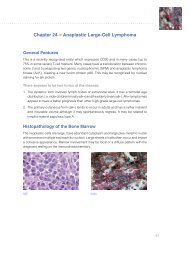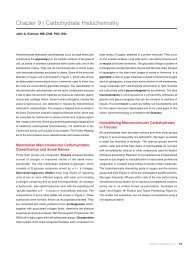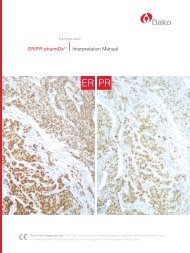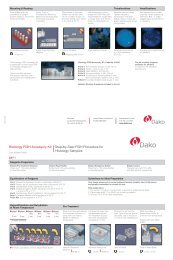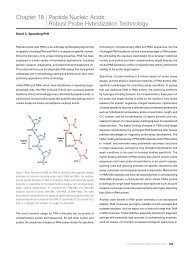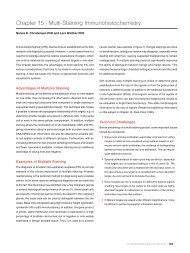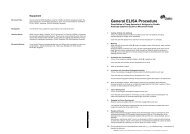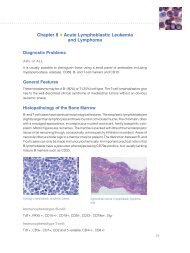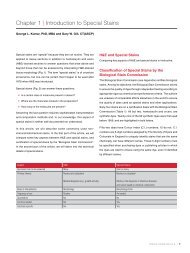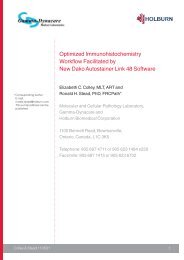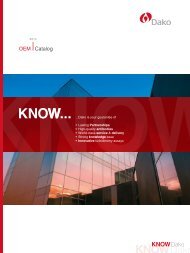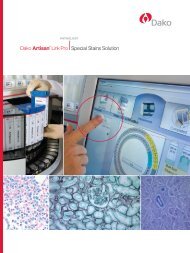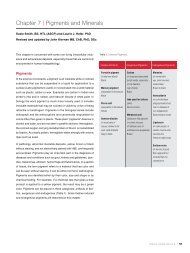Special Stains Use in Fungal Infections - Dako
Special Stains Use in Fungal Infections - Dako
Special Stains Use in Fungal Infections - Dako
Create successful ePaper yourself
Turn your PDF publications into a flip-book with our unique Google optimized e-Paper software.
No sta<strong>in</strong><strong>in</strong>g was seen <strong>in</strong> Cryptococcus or Candida, and very rare acid<br />
fast sta<strong>in</strong><strong>in</strong>g was seen <strong>in</strong> coccidiodomyces endospores (12). However,<br />
these sta<strong>in</strong><strong>in</strong>g properties are <strong>in</strong>consistent and should not be used for<br />
primary diagnosis. The cell walls of fungi are <strong>in</strong> general, not acid fast.<br />
Autoflourescent Fungi<br />
Some fungi or fungal components <strong>in</strong> the H&E sta<strong>in</strong>ed tissue sections<br />
are autofluorescent when exam<strong>in</strong>ed under ultraviolet light source<br />
(13). Candida species, Coccidioides immitis and Aspergillus species<br />
can exhibit bright green to yellow-green autofluorescence (14). When<br />
sections of these fungi are sta<strong>in</strong>ed with the PAS, bright yellow fungal<br />
autofluorescence aga<strong>in</strong>st a deep red-orange background is seen (15).<br />
Autofluorescence may help del<strong>in</strong>eate sparse or poorly sta<strong>in</strong>ed fungi <strong>in</strong><br />
H&E sta<strong>in</strong>ed sections, however this property is <strong>in</strong>consistent and should<br />
not be used for def<strong>in</strong>itive diagnosis. Most fungi <strong>in</strong> frozen or paraff<strong>in</strong><br />
embedded tissue sections also sta<strong>in</strong> nonspecifically with Calcofluor<br />
white, a cotton whitener that fluoresces under ultraviolet light (16). This<br />
rapid and a simple fluorescence procedure can be rout<strong>in</strong>ely used <strong>in</strong> the<br />
<strong>in</strong>traoperative exam<strong>in</strong>ation of fresh-frozen tissues for fungi.<br />
Immunoperoxidase sta<strong>in</strong>s can be used to identify certa<strong>in</strong> fungi <strong>in</strong><br />
smears and <strong>in</strong> formal<strong>in</strong> fixed, paraff<strong>in</strong> embedded tissue section. This<br />
technique, however, has only limited diagnostic use (17).<br />
References<br />
1. Chandler FW, Watts JC. Pathologic Diagnosis of <strong>Fungal</strong><br />
<strong>Infections</strong>. Chicago: ASCP Press; 1987.<br />
2. Haque AK, McG<strong>in</strong>nis MR. Chapter 10. Dail and<br />
Hammar’s Pulmonary Pathology. New York: Spr<strong>in</strong>ger;<br />
2008<br />
3. Liber AF, Choi HS. Splendore-Hoeppli phenomenon<br />
about silk sutures <strong>in</strong> tissue. Arch Pathol Lab Med. 1973;<br />
95:217-20.<br />
4. Schwartz J. The diagnosis of deep mycoses by<br />
morphologic methods. Hum Pathol. 1982; 13:519-33.<br />
5. Vacca LL. Laboratory Manual of Histochemistry. New<br />
York: Raven; 1985.<br />
6. Chandler FW, Kaplan W, Ajello L. Color Atlas and Text of<br />
the Histopathology of Mycotic Disease. Chicago: Year<br />
Book Medical; 1980.<br />
7. Youngberg GA, Wallen EDB, Giorgadze TA. Narrow-<br />
Spectrum histochemical sta<strong>in</strong><strong>in</strong>g of fungi. Arch Pathol<br />
Lab Med 2003; 127:1529-1530.<br />
194 | Connection 2010<br />
8. Hussa<strong>in</strong> Z, Mart<strong>in</strong> A, Youngberg GA. Blastmyces<br />
dermatitides with large yeast forms. Arch Pathol Lab<br />
Med 2001; 125:663-664.<br />
9. Kwon-Chung KJ, Hill WB, Bennett E. New, special sta<strong>in</strong><br />
for histopathological diagnosis of cryptococcosis. J Cl<strong>in</strong><br />
Microbiol. 1981; 13:383-87.<br />
10. Lazcano O, Speights VO Jr, Stickler JG, Bilbao JE,<br />
Becker J, Diaz J. Comb<strong>in</strong>ed histochemical sta<strong>in</strong>s <strong>in</strong> the<br />
differential diagnosis of Cryptococcus neoformans. Mod<br />
Pathol 1993; 6:80-84.<br />
11. Wood C, Russel-Bell B. Characterization of pigmented<br />
fungi by melan<strong>in</strong> sta<strong>in</strong><strong>in</strong>g. Am J Dermatopathol. 1983;<br />
5:77-81.<br />
12. Wages DS, Wear DJ. Acid-fastness of fungi <strong>in</strong><br />
blastomycosis and histoplasmosis. Arch Pathol Lab<br />
Med. 1982; 106:440-41.<br />
13. Mann JL. Autofluorescence of fungi: an aid to detection<br />
<strong>in</strong> tissue sections. Am J Cl<strong>in</strong> Pathol. 1983; 79:587-90.<br />
14. Graham AR. <strong>Fungal</strong> autofluorescence with ultraviolet<br />
illum<strong>in</strong>ation. Am J Cl<strong>in</strong> Pathol. 1983; 79:231-34.<br />
Direct Immunofluoresence (IF)<br />
Direct immunofluoresence (IF) can improve the diagnostic capability<br />
of conventional histopathology <strong>in</strong> the diagnosis of fungal diseases<br />
(18). The IF procedure, which can be performed on smears and on<br />
formal<strong>in</strong> fixed paraff<strong>in</strong> embedded tissue sections is helpful <strong>in</strong> confirm<strong>in</strong>g<br />
a presumptive histologic diagnosis, especially when fresh tissues<br />
are not available for culture or when atypical fungus forms are seen.<br />
The Division of Mycotic Diseases, Center for Disease Control, Atlanta<br />
(United States) and others have a broad battery of sensitive and specific<br />
reagents available for identify<strong>in</strong>g the more common pathogenic fungi.<br />
The immunofluoresence procedure has several advantages. F<strong>in</strong>al<br />
identification of an unknown fungus is possible with<strong>in</strong> hours after<br />
H&E and GMS sta<strong>in</strong>ed sections are <strong>in</strong>itially exam<strong>in</strong>ed. The need<br />
for time consum<strong>in</strong>g and costly cultures is often obviated by IF, and<br />
the hazards of handl<strong>in</strong>g potentially <strong>in</strong>fectious materials are reduced<br />
when microorganisms are <strong>in</strong>activated by formal<strong>in</strong> prior to IF sta<strong>in</strong><strong>in</strong>g.<br />
Prolonged storage of formal<strong>in</strong> fixed tissues, either wet tissue or paraff<strong>in</strong><br />
embedded, does not appear to affect the antigenecity of fungi. This<br />
antigenic stability makes possible retrospective studies of paraff<strong>in</strong><br />
embedded tissue and the shipment of specimens to distant reference<br />
laboratories for confirmatory identification. Most service laboratories,<br />
however, do not rout<strong>in</strong>ely use IF, s<strong>in</strong>ce the special sta<strong>in</strong>s have been very<br />
reliable for diagnosis <strong>in</strong> the day to day pathology practice.<br />
15. Jackson JA, Kaplan W, Kaufman L. Development of<br />
fluorescent-antibody reagents for demonstration of<br />
Pseudallescheria boydii <strong>in</strong> tissue. J Cl<strong>in</strong> Microbiol. 1983;<br />
18:668-73.<br />
16. Monheit JE, Cowan DF, Moore DG. Rapid detection of<br />
fungi <strong>in</strong> tissue us<strong>in</strong>g calcofluor white and fluorescence<br />
microscopy. Arch Pathol Lab Med. 1984; 108:616-18.<br />
17. Kobayashi M, Kotani S, Fujishita M, et al.<br />
Immunohistochemical identification of Trichosporon<br />
beigelii <strong>in</strong> histologic sections by Immunoperoxidase<br />
method. Am J Cl<strong>in</strong> Pathol. 1988; 89:100-05.<br />
18. Reiss E, de-Repentgny L, Kuykendall J, et al.<br />
Monoclonal antibodies aga<strong>in</strong>st Candida tropicalis<br />
mannans antigen detection by enzyme immunoassay<br />
and immunofluorescence. J Cl<strong>in</strong> Microbiol. 1986;<br />
24:796-802.



